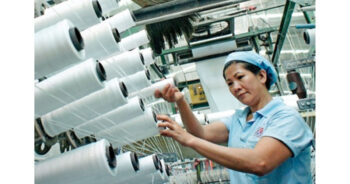 Raw material shortages are hampering global supply chains due to geopolitical tensions and China’s zero covid strategy. Such shortages have also impacted Vietnam.
Raw material shortages are hampering global supply chains due to geopolitical tensions and China’s zero covid strategy. Such shortages have also impacted Vietnam.
Despite global uncertainties, Vietnam’s economy is recovering at a considerable pace post-COVID-19. As per the World Bank (WB), Vietnam’s GDP growth in 2022 is projected to reach 5.5 percent from a low of 2.6 percent in 2021 due to the pandemic. However, challenges remain as the consumer price index (CPI) has been steadily increasing to a seven-month high, recorded at 2.4 percent in March, a rise of 1 percent compared to the prior month.
The upsurge in prices has been primarily driven by production cost spikes, which have resulted from a severe shortage of input material for manufacturing across industries. In fact, mainstream industries are faced with another challenge after COVID-19: surging costs and input shortages, exacerbated by supply chain disruptions.
The Vietnam Textile and Apparel Association indicates that the prospects for the industry in Vietnam are bright in the long term, in light of Vietnam’s reopening and implementation of several free trade agreements (FTA). The textile industry is projected to generate up to US$43.5 million for Vietnam’s economy this year under ideal conditions.
However, the ability of textile firms to fulfill orders are currently undermined by supply chain disruption due to border closures in China due to the pandemic, and surging costs due to the Russia-Ukraine crisis.
China has long been the leading exporter of fabrics and garment accessories for Vietnam; between 50 percent and 55 percent of raw materials and textile accessories are imported from China for Vietnam’s textile industries. However, as China shows no sign of abandoning its zero-Covid approach, many shipments of fabrics and garment pieces are piling up at its ports, leading Vietnamese garment firms to delay production and delivery.
Textile manufacturers in Vietnam face challenges and have been forced to place orders with their Chinese suppliers months in advance to secure input materials as Chinese factories are forced to operate below capacity.
The situation has deteriorated as the price of cotton has spiked. The Vietnam Cotton and Spinning Association (VCOSA) recorded a spike in cotton prices imported from Brazil, the US, and India by 0.87 percent, reaching around US$1,625 per tonne. This has eaten into the revenue of manufacturers in Vietnam as it is difficult for them to pass on the surge in price to customers in a short term.
In addition, the US government on June 21 passed the Uyghur Forced Labor Prevent Act which prevents companies from importing goods, including cotton, which is from China’s Xinjiang region to the US. This has further added to input costs.
In an attempt to support the textile industry, the Ministry of Industry and Trade (MoIT) stated they would speed up the implementation of the development strategy for the textile and footwear industry towards sustainability while looking to adopt cutting-edge technology to upgrade the productivity of the two industries. Textile firms have made effort to diversify suppliers to loosen their dependence on China for input.




















